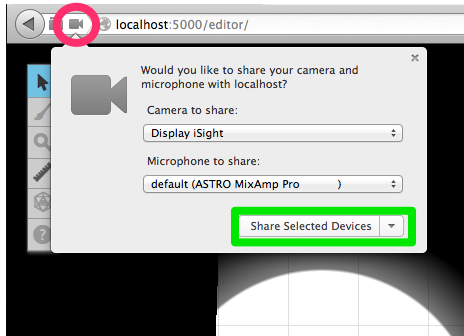Video and Voice Chat
From Roll20 Wiki
Roll20 features a built-in WebRTC video and voice chat feature (powered by Tokbox's OpenTok 2.0) that allows you to communicate with other players. It is enabled as the default video chat technology starting with the Rugged Reroll update. WebRTC is high-definition and runs natively in your browser without the need for any additional plugins. It's also adaptive so it works well with low-bandwidth connections.
Once at least two people are in the game using WebRTC, you should see a dialog box along the top of your screen that asks you to give permission for Roll20 to use your camera/microphone.
| Note: If you aren't having much luck with the built-in video/voice chat, you might also try running your game in a Google+ Hangout, which offers an alternative way of having video/voice chat in your game. Read more... |
Enabling and Disabling WebRTC Video & Voice Chat
In Google Chrome:
A dialog box will appear along the very top of your browser screen. Click "Allow." (You may only have to do this the first time you use WebRTC).
Note that you can click the little camera icon located in the far-right of your address bar to change the settings of what camera/microphone is being used.
In Mozilla Firefox:
A dialog box will appear, click on "Share Selected Devices" to allow Roll20 to start video chat (highlighted in green below). If for some reason a dialog box does not appear, or if you wish to change your settings after the game has started, click on the Camera icon (highlighted in pink below) to change your settings.
Go to the My Settings tab (the gear icon) in the Sidebar (on the top-right side of the screen). Scroll down to the bottom of the tab to find the Video + Voice heading. There will be three related drop-down menus underneath. They are:
I want to Broadcast to others: this controls whether or not you will broadcast video and voice, voice only, or nothing to other players in the game.
I want to Receive from others: this controls whether or not you will receive video and voice, voice only, or nothing from other players, if they are broadcasting at all.
Video/Player Avatar Size: This controls the size of the player avatars that are shown in the Player Zone in the bottom-left side of the screen. There are four size options available: Large (200px x 200px), Regular (150px x 150px), Small (100px x 100px) and "Names Only". If the last option is selected, the portrait image is hidden entirely and all that remains is the user's name plate. Note that if you choose "Names Only" you will still receive or send any video or voice broadcasts. You need to use the "Broadcast To Others" setting if you want to broadcast voice-only, or nothing at all.
Managing Volume
While video/voice is enabled in Roll20, hover your mouse on the bottom right corner of a player's portrait in the Player Zone. This action will pop up a volume slider that you can use to fine tune a player's mic volume to be heard properly. It's important to note that a slider exists on your own portrait and tuning your personal mic volume affects how other players in Roll20 hear you.
Switching Devices
To switch between multiple microphone and webcam devices, once again hover your mouse on the bottom right corner of your avatar in the Player Zone. Next to the volume slider that pops up is a wrench button. Clicking on this button brings up a new window where you can specify which devices you wish to use for chat.










